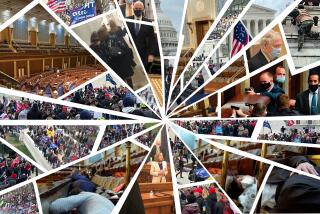Pentagon Shows It’s Home of the Brave
- Share via
WASHINGTON — Along the miles of hallways at the Pentagon on Wednesday, the smoke still stung the eyes and clung in a thin haze. In the center courtyard, empty body bags lay in long, neat rows.
And outside the entrance to every darkened corridor leading from the devastation--caused when a hijacked airliner slammed into this symbol of American military might the day before--stood a soldier in camouflage, holding an M-16 rifle.
But since early Wednesday morning, when this vast building defiantly reopened for business, the people who work here have been doing their best to ignore all that. They have a military to run, and, from the highest general to the lowest private, they were trying grim-faced to do that--even as rescue workers labored outside the massive structure to extinguish a stubborn fire that still blazed.
“I feel that it’s our job to protect the country and I just need to be there,” said Kimberly Lenzer, a clerical worker who along with thousands of others walked 15 minutes from the Pentagon City subway stop to get to work. “I think everyone feels that way. Even if they took down the building, it wouldn’t matter. It would still go on.”
With a giant hole torn in the Pentagon--its interior exposed, its windows shattered and its gray facade burned black along much of one side--efforts to resume work as usual were not easy and not always successful.
In some parts of the vast building, it appeared outwardly as if nothing had happened. Secretaries sat at their desks sipping coffee, people bustled in and out carrying sheaves of documents, and others sat typing at their computers.
But not even the most focused worker could ignore the fact that something was terribly wrong. All morning and into the early afternoon, smoke billowed up from the crash scene. Firefighters with picks and axes, clad in thick protective gear, were everywhere.
At one minute before noon, someone saw something on a radar screen that looked briefly like it was moving toward the Pentagon. Military police ran through the hallways shouting evacuation orders, and people began walking swiftly toward exits. A few minutes later it was over--a false alarm.
But when a small maintenance vehicle of the kind that cruises the halls in the building every day sounded its usual horn to alert pedestrians it was coming, about a dozen people jumped.
“That was too close and too loud for a day like today,” one man muttered.
The vast building, usually teeming with more than 24,000 workers, was relatively empty. There was no way to know how many people showed up for work Wednesday. Chillingly, the computerized security system that normally counts people walking into the building was not working. Guards checked passes by hand.
But it was obvious to anyone who is at the Pentagon regularly that many had stayed home. Others, with no desks to go to, were sent home shortly after they arrived.
In the morning, some walked the halls with surgical masks over their faces. Police tape was strung up across the entrances to closed corridors. Hand-lettered signs directed workers where to go. In the central courtyard, outside the cafe that Pentagon employees have long jokingly labeled Ground Zero, weary firefighters wiped their faces and spit soot onto the ground.
“I wasn’t going to come in, but everyone in my office was,” said Aquilla Carter, a civilian financial analyst, who carried a tall bottle of water to wet her throat and stinging eyes amid the smoke. “I was somewhat leery. But to be honest, I have great faith.”
Rescue workers going about their grim task outside the building struggled to keep faith as well. Their primary task Wednesday was to douse the blaze and shore up the damaged building before the search for victims could begin.
Bernie Dake, a Salvation Army volunteer, said that early in the day, workers set up a grid of empty white body bags, about 100 in all, in five rows of 20 each. Then they removed them. Later, they began bringing them out again, one by one. This time, however, the bags were not empty, though Dake said none appeared to hold full corpses.
“It looked like it was a makeshift morgue,” Dake said.
About 50 Salvation Army officers and more than 150 volunteers dispensed food and drink and counseled exhausted rescuers. “They’re . . . working very hard and really should be looked at as heroes,” Dake said.
President Bush toured the site late in the afternoon, offering thanks and encouragement.
“I am overwhelmed by the devastation,” he said. “The nation mourns, but we must go on.”
Deep inside the ruined wedge of the building, Army Gen. Larry D. Gottardi walked with a flashlight through darkened offices filled with smoke..
Defense Secretary Donald H. Rumsfeld was in the building at 5:30 a.m., and he met throughout the day with security officials, spokeswoman Victoria Clarke said.
Others had no offices to go to. Arlene Demamaskas, a civilian employee of an office she would not identify, near the edge of the impact, spent most of the morning sitting in a cafeteria that was closed but for vending machines. With her office in a closed-off section of the building, she was stuck munching an apple and wondering what to do next.
By midday, she and the rest of her department were on their way home.
*
Times staff writer Warren Vieth contributed to this report.
More to Read
Sign up for Essential California
The most important California stories and recommendations in your inbox every morning.
You may occasionally receive promotional content from the Los Angeles Times.












